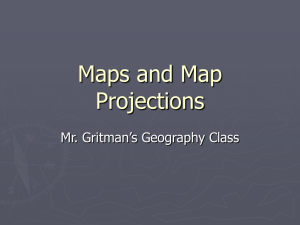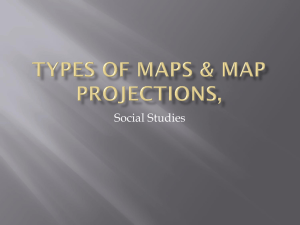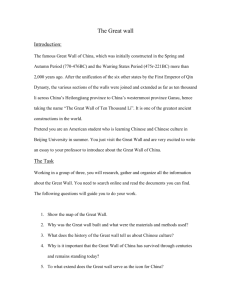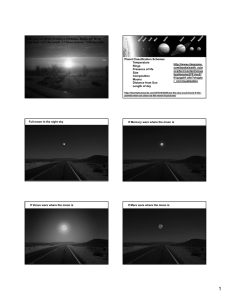AP HUMAN GEOGRAPHY
advertisement
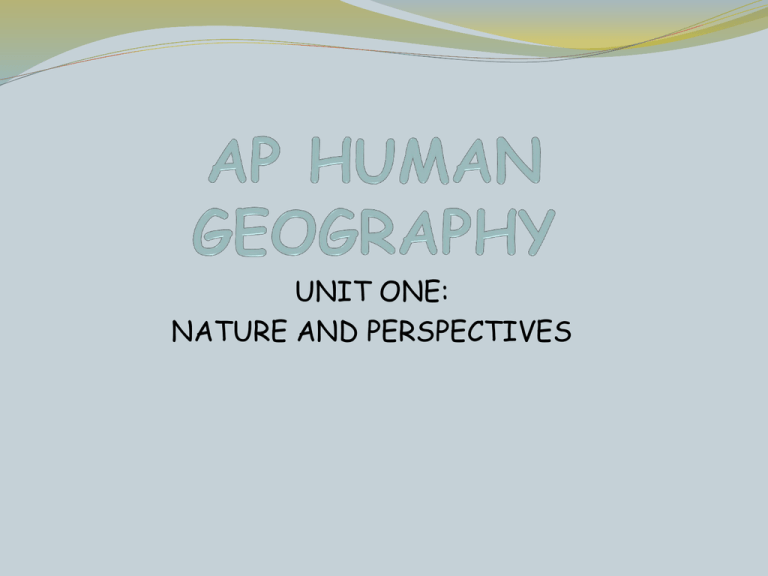
UNIT ONE: NATURE AND PERSPECTIVES What is Geography? Eratosthenes – 1st to Coin the Word Geography Geo + Graphy = Earth + To Write 2 ? Geographers Ask: Where? And Why? 2 Main Areas of Geography: Physical & Human Physical: Natural forces….climates, landforms, etc. Human: human activities…Religion, language…ways we make a living, cities, etc. w/in human – 2 main areas: culture & economy 1st ½ of book – culture…. 2nd ½ - economy What is Geography? Geography is the study of Earth in a spatial perspective What does spatial mean? Spatial = space How things are laid out, organized, and arranged on the earth in different scales. What are scales? The level at which we look @ things Examples: local, regional, national, or global Using a map to spatially locate the source of a 1854 cholera outbreak in London. What scale is this map drawn at? 4 Map Scale: How much does it show? 5 streets? City? Country? Or..Continent? Locally or local scale: large scale; see unique aspects Globally or global scale: small scale; can see similarities **NOTE: large scale = small area small scale = large area; the smaller the scale the less detail is given (see slide) 5 Show map scale 3 ways : fraction (1/24,000) or ratio (1:24,000) Graphic bar scale (see p. 10, fig. 3) written statement (“1 inch equals 1 mi.) -left = distance on map -right = dist. on the Earth Note: large scale = small area small scale = large area The smaller the scale the less detail is given. Scales on maps On this map the scale is given as a representative fraction (1/253,440) and also as a ratio (1:253,440). The fraction and the ratio mean the same thing: that one unit of distance on the map represents 253,440 of the same units on the ground. 7 Which map would show the largest area? 1 / 2,500,739 Or 1:10,000 8 Scale Differences: Maps of Florida The effects of scale LARGE SCALE = small area… Small scale= LARGE AREA 9 MAPS Maps: science of mapmaking = cartography Map = 2D or flat- scale model of some part of the Earth Mental Maps – Cognitive landscape in the human mind – accurate around our areas of home, school and workplace…elsewhere may be blank 2 main purposes of maps: Storing Reference Info: Ex.: How do we get from here to there? …or… Where is Zimbabwe? Communications Tool Ex.: Show migration or spread of disease Types of maps & info on maps: physical maps: show landforms of an area Use colors to show relief— difference levels in land elevations -green usually = lo elevations -orange or brown = hi elevations 11 Topographical Presents horizontal & vertical positions of features represented -shows relief in measurable form. -Uses contour lines (isolines) to show the shape & elevation of an area (shape of the Earth’s surface) -Lines close together indicate steep terrain -Lines far apart indicate flat terrain. Isolines Isolines calculate date between points to show change in data This Isoline map shows overage rainfall in Mexico Weather maps showing temperature contours – use isotherms – and are the most common isoline maps Political maps: show places divided by states (aka “countries”), cities, counties, etc. -usually show rivers, major lakes, oceans, etc., elevations….capital cities show w/ star 14 Economic maps: type of thematic map that shows natural resources in areas and/or ways that people make a living; legends may show mines, factories, power plants, etc. NOTE: the economy of a country is the way the money is earned, used, spent, controlled, issued, invested, etc. Thematic Maps: Provides info on a single topic (population, rainfall…) Using Thematic Maps: shows comparison of statistical data, like population or income -can view facts about places by comparing the patterns of shaded areas or colors on the map. Dot Map 16 Thematic Maps Chloropleth: (Gk.: for “place” + “value or magnitude”): Thematic map w/ areas colored, shaded, dotted, or hatched so have darker/lighter areas in proportion to density of whatever aspect U R are looking -show amt. of some “phenomenon” (some event or thing which occurs) like ratios, %, etc., using these colors Flow-line maps – use lines of varying thickness to show the direction and volume of a particular geographic movement pattern Cartogram: Shows some quantity or value by shape or size of a region GDP Military Spending p. 47 Rubenstein – Population Distribution 19 Reference Maps- Tool to view boundaries of census geographies, cities, counties, cities/towns, urban areas, congressional districts, census tracts, census blocks, & more. Note: some of these terms overlap MAP PROJECTIONS To create maps, cartographers project the round Earth onto a flat surface—making a map projection. There are many different map projections. Distance, shape, direction, or size may be distorted by a projection. Each has advantages and disadvantages. 21 MERCATOR PROJECTION Flemish Cartographer: Gerardus Mercator 1569 Purpose: Navigate ships across the Atlantic Ocean between Europe & the Americas Used grid system of meridians and parallels good for travelling east and west BUT…distorts size of areas especially @ North and South poles Antarctica and Greenland look HUGE on map Mercator is conformal, meaning shapes stay the same. Mercator Projection 23 ROBINSON PROJECTION Tries to correct for distortion in high north and south by curving those areas inward on paper Longitude lines get closer @ North & South Poles – so sizes of landmasses are more accurate BUT…other landmasses look smaller Robinson attempts to balance all distortions by making errors in all 4 ways: Shape, size, distance and direction Good for general use and often used for wall maps in classrooms 25 Peter’s Projection Arnold Peters – 1974 Focuses on keeping landmasses equal in area Shapes are distorted - resulting in map quite unfamiliar w/ most viewers BUT…Humanitarian Aid groups tend to like this map because other maps have made Africa and Latin America seems smaller than they are Peters Projection 27 Goode’s Homosoline Projection Like the Robinson Projection - it tries to balance aarea and form Sacrifices a bit of both to create a more visually practical representation of the earth’s surface Interrupted Goode Homolosine Projection 29 Land Ordinance of 1785: pp. 10-12 Township & Range system used to divide western lands of USA Township (TS) = 6 sq. miles per side each TS divided into 36 sections (1 mi x 1 mi.) sections divided into quarter sec.’s which = a typical “homestead” (160 acres) for settlers Used principal meridians (some of the N & S lines) & base lines (some E & W lines) to form squares 30 Township & Range System in the U.S. Using GRIDS to lay out land areas Principal meridians & east-west baselines of the township system. Townships in NW Mississippi & topographic map of the area 31 : Remote sensing GIS GPS remote sensing: satellites orbiting (or other long-distance) give data RE: surface -shows vegetation, ice, weather patterns, etc.; scans like TV camera using pixels -resolution: smallest feature that can be picked up by the camera -some 1 meter across…weather satellites pick up several km across (need lg. area) 32 GPS: Global Positioning System: using map to find way to another location Can use hand-held or computers in cars - gets signal from GPS satellites 33 GIS INFORMATION SYSTEM Created fusing remote sensing Hi-perform. computer system; processes geog.-data -In layers: can show 1 or several at a time (F.1-5, p.12) -Shows earthquake faults, pop. data, manufacturing, soil types, etc. EX: of use: street map + pop. map = bus routes needed (# w/in walking distance of stop) Layers of a GIS Fig. 1-5: A geographic information system (GIS) stores information about a location in several layers. Each layer represents a different category of information. 35


